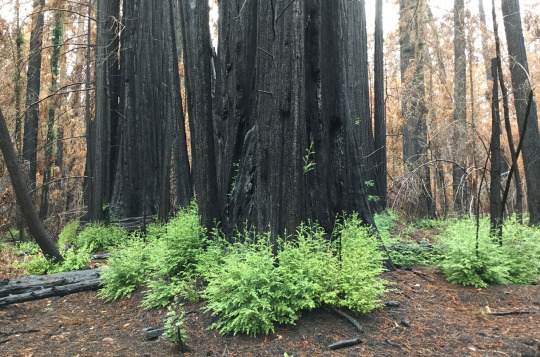Text

Vegan Khoresht-E-Havij Aloo (Persian Carrot & Golden Plum Stew)
17 notes
·
View notes
Text

New comic alert!!
One of my side projects this spring has been a brand new instructional foraging comic PDF, this time about relatively easy-to-find-and-ID fruit in the Eastern US! Like wild fruit, this comic is FREE (though you can leave a tip as a thank-you if you'd like.)
Read it here!
2K notes
·
View notes
Text
Ancient redwoods recover from fire by sprouting 1000-year-old buds

Article | Paywall free
When lightning ignited fires around California’s Big Basin Redwoods State Park north of Santa Cruz in August 2020, the blaze spread quickly. Redwoods naturally resist burning, but this time flames shot through the canopies of 100-meter-tall trees, incinerating the needles. “It was shocking,” says Drew Peltier, a tree ecophysiologist at Northern Arizona University. “It really seemed like most of the trees were going to die.”
Yet many of them lived. In a paper published yesterday in Nature Plants, Peltier and his colleagues help explain why: The charred survivors, despite being defoliated [aka losing all their needles], mobilized long-held energy reserves—sugars that had been made from sunlight decades earlier—and poured them into buds that had been lying dormant under the bark for centuries.
“This is one of those papers that challenges our previous knowledge on tree growth,” says Adrian Rocha, an ecosystem ecologist at the University of Notre Dame. “It is amazing to learn that carbon taken up decades ago can be used to sustain its growth into the future.” The findings suggest redwoods have the tools to cope with catastrophic fires driven by climate change, Rocha says. Still, it’s unclear whether the trees could withstand the regular infernos that might occur under a warmer climate regime.
Mild fires strike coastal redwood forests about every decade. The giant trees resist burning thanks to the bark, up to about 30 centimeters thick at the base, which contains tannic acids that retard flames. Their branches and needles are normally beyond the reach of flames that consume vegetation on the ground. But the fire in 2020 was so intense that even the uppermost branches of many trees burned and their ability to photosynthesize went up in smoke along with their pine needles.
Trees photosynthesize to create sugars and other carbohydrates, which provide the energy they need to grow and repair tissue. Trees do store some of this energy, which they can call on during a drought or after a fire. Still, scientists weren’t sure these reserves would prove enough for the burned trees of Big Basin.
Visiting the forest a few months after the fire, Peltier and his colleagues found fresh growth emerging from blackened trunks. They knew that shorter lived trees can store sugars for several years. Because redwoods can live for more than 2000 years, the researchers wondered whether the trees were drawing on much older energy reserves to grow the sprouts.
Average age is only part of the story. The mix of carbohydrates also contained some carbon that was much older. The way trees store their sugar is like refueling a car, Peltier says. Most of the gasoline was added recently, but the tank never runs completely dry and so a few molecules from the very first fill-up remain. Based on the age and mass of the trees and their normal rate of photosynthesis, Peltier calculated that the redwoods were calling on carbohydrates photosynthesized nearly 6 decades ago—several hundred kilograms’ worth—to help the sprouts grow. “They allow these trees to be really fire-resilient because they have this big pool of old reserves to draw on,” Peltier says.
It's not just the energy reserves that are old. The sprouts were emerging from buds that began forming centuries ago. Redwoods and other tree species create budlike tissue that remains under the bark. Scientists can trace the paths of these buds, like a worm burrowing outward. In samples taken from a large redwood that had fallen after the fire, Peltier and colleagues found that many of the buds, some of which had sprouted, extended back as much as 1000 years. “That was really surprising for me,” Peltier says. “As far as I know, these are the oldest ones that have been documented.”
... “The fact that the reserves used are so old indicates that they took a long time to build up,” says Susan Trumbore, a radiocarbon expert at the Max Planck Institute for Biogeochemistry. “Redwoods are majestic organisms. One cannot help rooting for those resprouts to keep them alive in decades to come.”
-via Science, December 1, 2023
11K notes
·
View notes
Text
Increasing the diversity of native plants in a single urban green space resulted in a sevenfold increase in the number of insect species after three years, Australian researchers have found.
According to the study’s authors, there had previously been “little empirical evidence of how specific greening actions may mitigate the detrimental effects of urbanisation”.
[...]
Researchers measured baseline insect numbers the year before greening began, when 12 indigenous plant species were introduced to the space, and subsequently conducted insect surveys for the following three years.
They identified 94 insect species in total, 91 indigenous to the Australian state of Victoria. The researchers estimated that by the final year of the study there were about 7.3 times more insect species than originally present, even though only nine plant species remained.
The team also found substantial increases in the number of predator and parasitoid insect species, which help to regulate populations of pest insects.
“These are two key groups that provide a really good ecological signal that the trophic network and all the proper interactions are happening at the site,” Mata said.
2K notes
·
View notes
Text
In a consumer society, contentment is a radical proposition. Recognizing abundance rather than scarcity undermines an economy that thrives by creating unmet desires. Gratitude cultivates an ethic of fullness, but the economy needs emptiness.
Robin Wall Kimmerer, Braiding Sweetgrass
526 notes
·
View notes
Text

Blueberry Nettle Cheesecake (Vegan & Gluten-Free)
48 notes
·
View notes
Text


Gâteau Vegan au Citron de Nigella Lawson / Tender Vegan Lemon Cake by Nigella Lawson
68 notes
·
View notes
Text
call me an old soul, but I find peace in nature, nights, moon, sunsets, breezes, books, poetry, flowers, the smell of rain, and people who feel like hug
4K notes
·
View notes
Text


Mending jeans where the pockets had started to rip away
146 notes
·
View notes
Text

I'm sure this makes it's rounds every now and again, but I will never not post this. Being an anarchist is about being involved, not in your scene, or on your computer, but in the world around you, and where you live. It's not supposed to be easy.
225 notes
·
View notes
Text
Totally don't endorse the idea of gurella gamifying benches/public spaces >~>


That would be illegal!! And too easy to do just takes some paint... and rocks... So... don't??? I guess??
143 notes
·
View notes
Text

Well, you know, some bathroom graffiti offers insight.
206K notes
·
View notes











